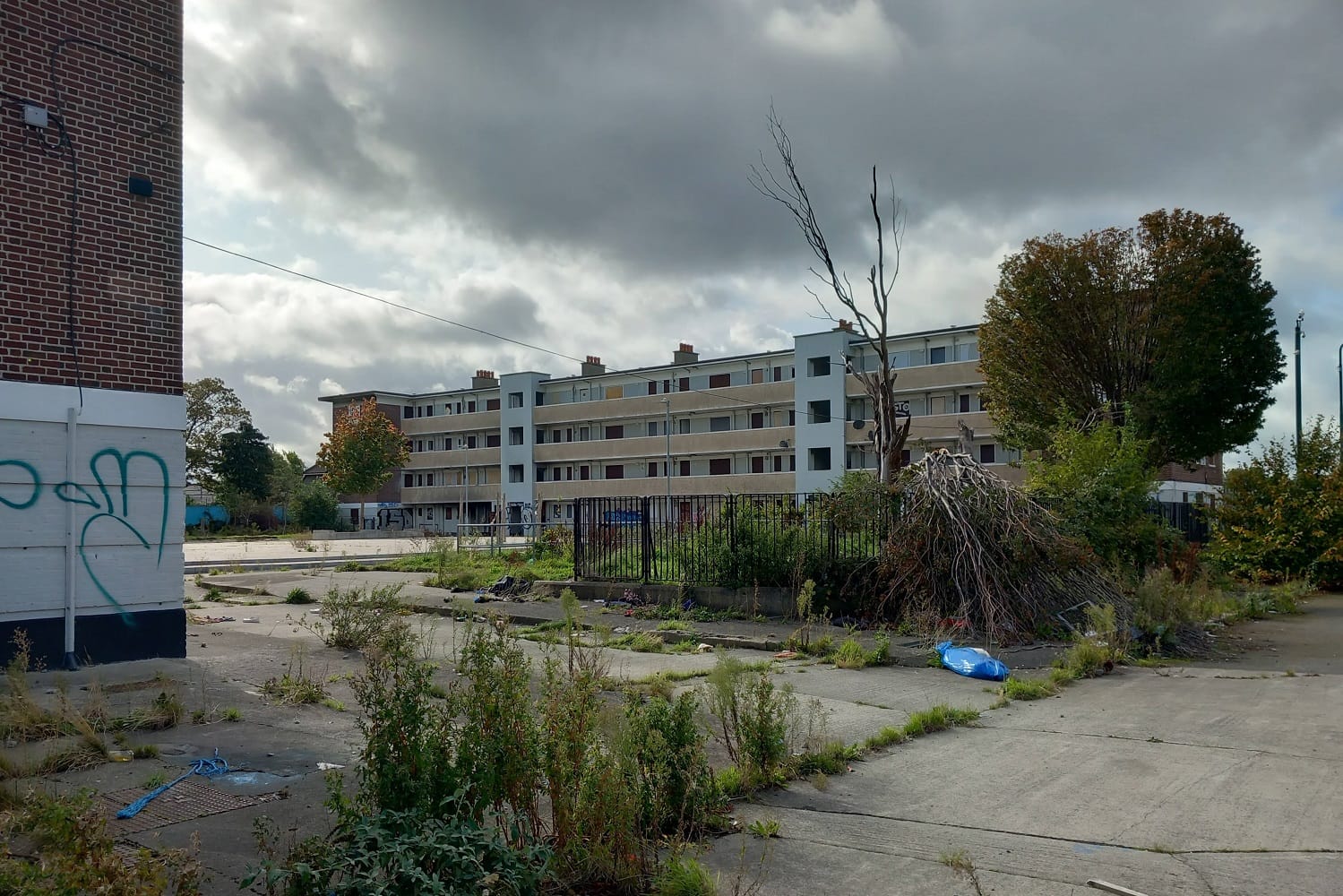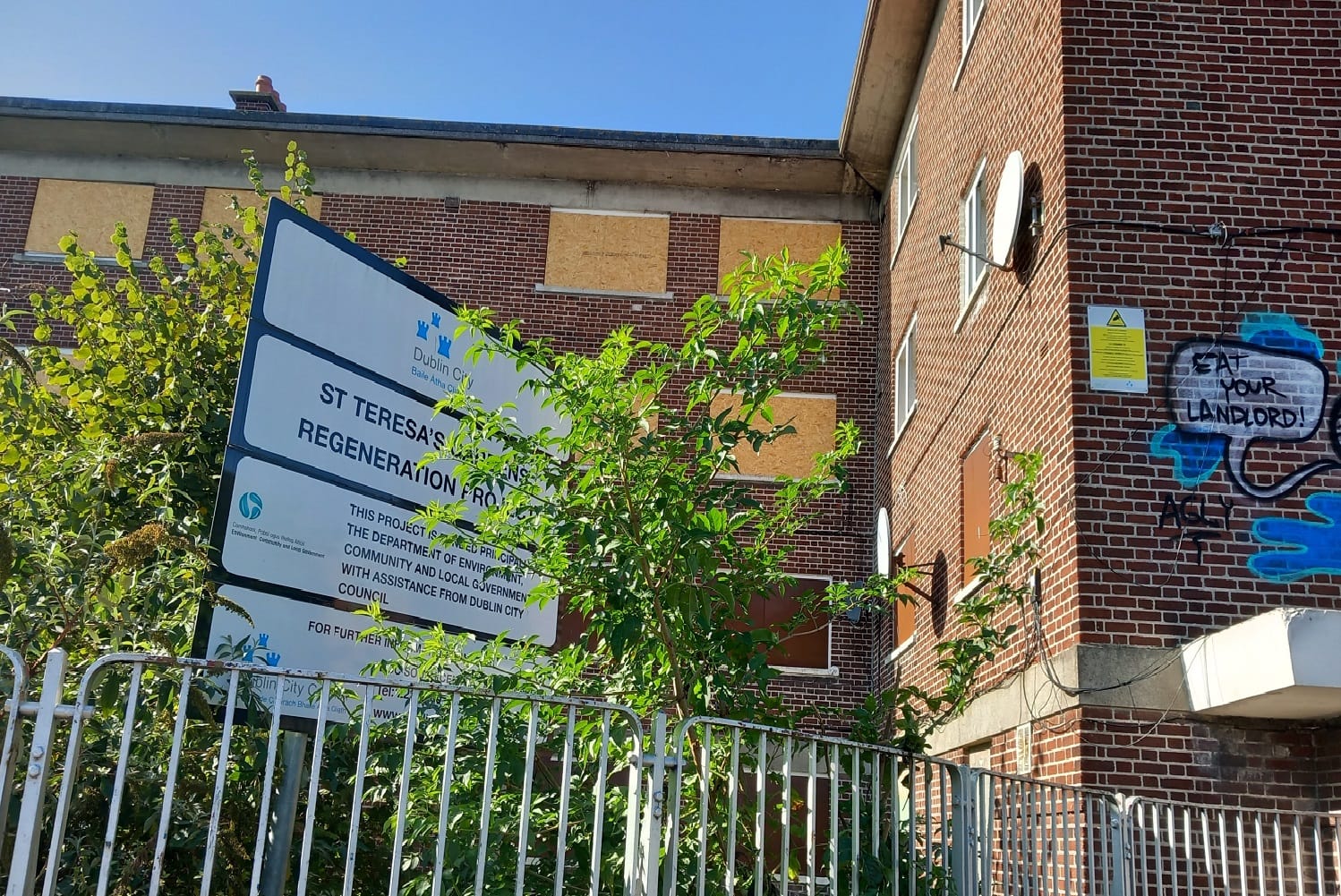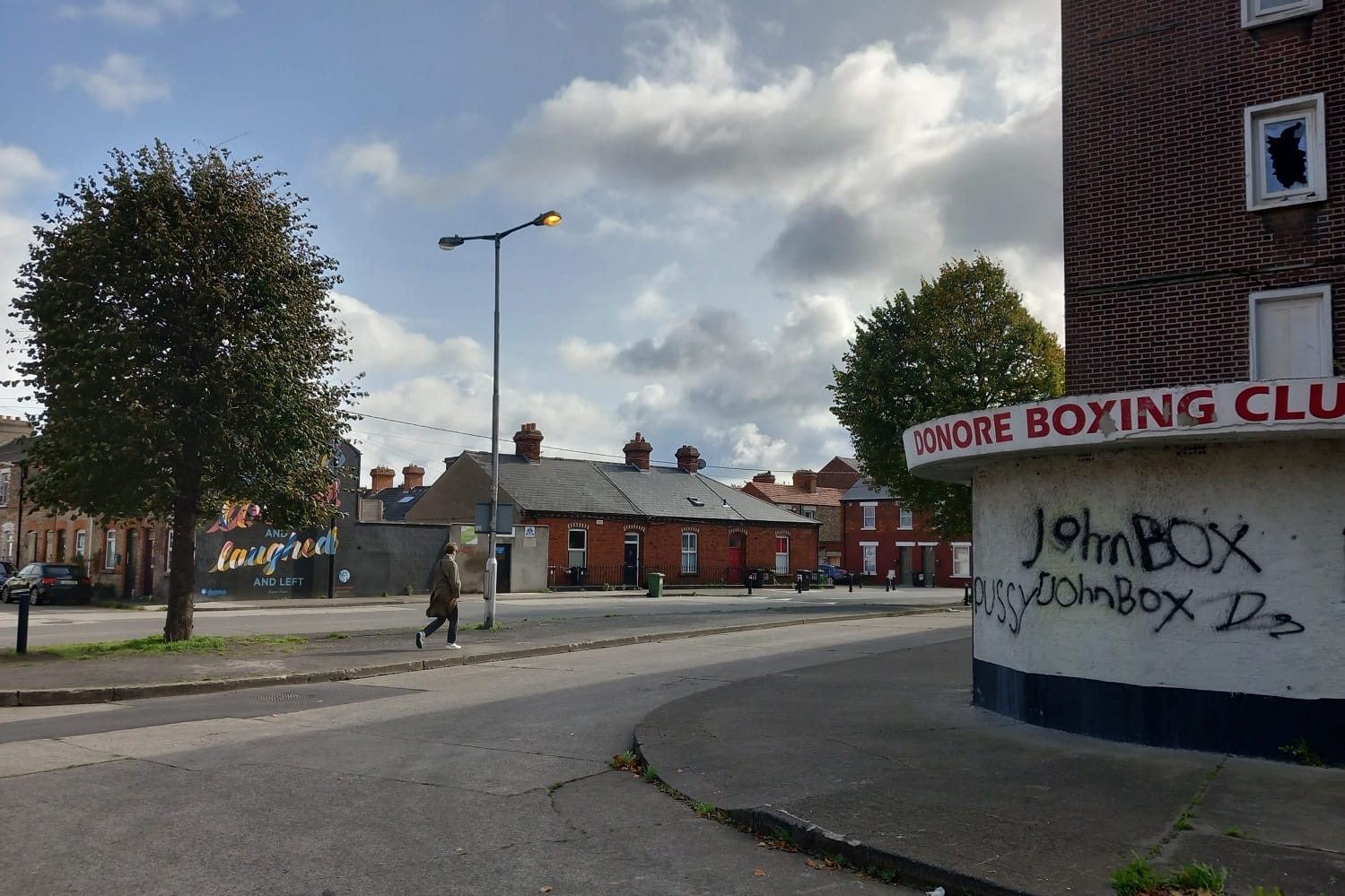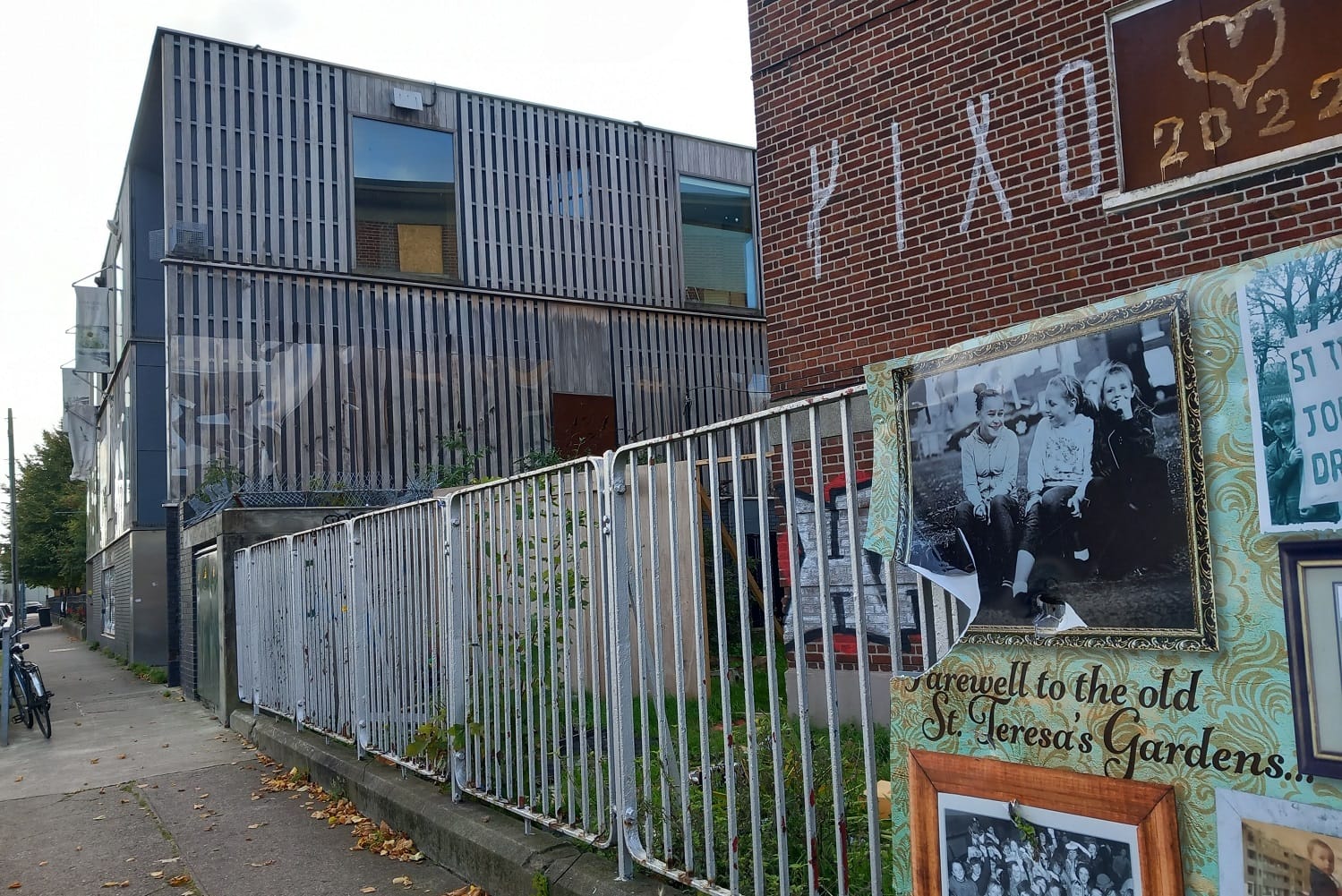What’s the best way to tell area residents about plans for a new asylum shelter nearby?
The government should tell communities directly about plans for new asylum shelters, some activists and politicians say.
The sports pitches are long gone. The playground too. The community centre burned in 2021 and the council has left it a charred husk. “It’s so disheartening.”

On a recent Thursday, late morning, a man in high-vis could be seen working inside the burnt-out community centre on Donore Avenue in the south inner-city.
“They’ve been doing clearing-out work for the last few weeks,” says Father David Corrigan, standing in the sunny grounds of St Teresa’s Church, next to the community centre.
A fire broke out in the council-owned centre in June 2021, and it’s been closed ever since. The process of getting it reopened has been “painfully slow”, Corrigan said.
Finally, earlier this year, Dublin City Council set out a five-stage timeline for re-opening. Stage one, “Strip out and preliminary design”, was meant to be done in four months, between April and July. It wasn’t.
“This is simply unacceptable,” wrote Stephen Rourke, chair of the Donore Project Consultative Forum, in a 31 August email to other members of the forum.
In another part of the city, a wealthier part of the city, with residents who had more influence and connections to government, a relatively small project like refurbishing a fire-damaged building would never have taken this long, says Rourke, last Wednesday, 27 September, over coffee in the Art of Coffee on Thomas Street
And it’s not just the community centre. This part of the city has been kind of in limbo for years.
Ten of the 12 blocks of the St Teresa’s Gardens flat complex were demolished by 2016. The playground is gone as well. The sports pitches are closed off, overgrown, off limits for even longer. The community centre is burnt-out for years now.
The council and the Land Development Agency (LDA) and private developer Hines conjure visions of a shiny future via slick architectural drawings and plans of the hundreds of new apartment blocks on these 27 acres in the heart of Dublin 8 – an area bigger than St Stephen’s Green.
But, for now, the reality on the ground here is dereliction and neglect.
The remaining two blocks of flats are a rotten core of dereliction in the neighbourhood, windows smashed out or boarded up, smeared with graffiti, empty except for the boxing club on the ground floor, which is still operating. The rest of the site is abandoned.



“It looks dismal, it looks derelict,” says Karen Jordan, the principal of the local St Catherine’s National School. “The area is going backwards. In 2023, that’s just a shame on the council.”
The council has not replied to a series of queries sent last Thursday about the state of the area, and the slow progress on the community centre.
The fire at the community centre appears to have been an accident, says Rourke.
“There was a police inquiry and the police inquiry found that there wasn’t malicious intent,” he says. “It was an accident. I think it happened in the roof garden area.”
Rourke was chairman of the St Teresa’s Gardens Regeneration Board before that was wound up in June 2022, and replaced by the Donore Project forum.
This new forum is meant to play a similar role, but for a broader area – not just the St Teresa’s Garden site, where there’s a plan for the LDA to build 543 cost-rental and social homes – but also the Player Wills and Bailey Gibson sites, where the private developer Hines has plans to build hundreds more homes.
The planning permissions for the Hines projects are tied up in court challenges. The LDA project has planning permission, but it looks unlikely to move forward until the Hines projects can, as they will have interlocking infrastructure, says Rourke.
The council is only one player in the complex, multi-part redevelopment and revival of this blighted area, he says
But it’s not bringing a sufficient sense of urgency to the pieces it has direct control over, like the community centre – or even small things like the broken lock on the door to an apartment building it has in the area, Rourke says.
Burnt out in June 2021, the centre might be back open in 2025, says local Sinn Féin Councillor Máire Devine, by phone on Monday. “I’d say that’s realistic.”
Taking this long to renovate a small building is just inexplicable, says Jordan, the principal at St Catherine’s.
“If the canteen in the council offices burnt down, it’d already be replaced,” she says.
The fire at the community centre left holes in the roof, says Rourke. The council didn’t cover them fast enough, he says.
“There was an issue of the damage that was caused on the night of the fire as well but my understanding from talking to people is that even subsequent to that the water damage on a day like today had a significant impact on the structure of the building,” he says.
The council has not responded to a query asking if this is accurate, sent last Thursday.
Rourke says the police inquiry and the insurance issues “were probably sorted out towards the tail end of that year”.
But for all of 2022 and much of 2023, nothing happened with the building. It’s only recently that workers have been hauling out all the stuff inside that was damaged by fire and water.

“Some people in the community have been saying this wouldn’t all have taken as long in a more middle-class, salubrious part of Dublin,” says Rourke.
He says he lives around Glasnevin, not far from the Na Fianna GAA Club. Back in April 2018, the club raised concerns that plans for building the MetroLink would mean they’d “lose pitch facilities for the duration of the project”.
Taoiseach Leo Varadkar, among others, backed the club’s concerns. Within weeks, the head of the National Transport Authority said it would consider other options, to avoid impacting the Na Fianna and adjoining school pitches.
“That was sorted in about three weeks,” says Rourke. “Members of Na Fianna are prominent politicians, local TDs, there’d be broadcasters, barristers, solicitors.”
There has not been that same urgency to replacing the Boys’ Brigade pitches the Donore Avenue community lost more than 15 years, the playground they have lost, or the community centre that remains burnt out and un-usable, says Rourke.
Jordan, the principal, said that when she learned that the former Boys’ Brigade sports pitches have just been sitting there for so many years, she couldn’t believe it. “I was like, What is that!? Do you know how often I’d be down here with the kids!?”
The council won’t even let local children around Donore Avenue play on vacant council land that’s been sitting there for years, awaiting development, Rourke says. “They’ve had an unfortunate track record with what it’s called ‘meantime use’,” he says.
“So I suppose there is a bit of a non-caring attitude in terms of not really realising the impact three or four months here and there might have on the lives of young people,” he says.
The council has not responded to a query sent last Thursday about whether it would have acted with more urgency to reopen the community centre if it were in a wealthier area with more influential residents.
The community centre closed down for Covid, and then when that ended, burnt down and has sat there since as a charred husk.
That meant the rooms there couldn’t be used for clubs and activities anymore. “As a school, we used to use the community centre for years for our end-of-year concert,” says Jordan, the principal at St Catherine’s.
They’d get 200 parents in to see their kids on stage, she says. “Now we don’t do that anymore,” she says.
The school also can’t use the hall for physical education, or for drama, or other things they don’t have enough room for at the school itself, she says. “It’s devastating.”
St Catherine’s has an afterschool scheme, and the provider used to bring students down to the community centre on rainy days, Jordan says.
Now, on those days, they’ve nowhere inside to take the kids. “I guess some kids like splashing in puddles in their wellies, but …” she says.
There was a breakfast club in the morning at the community centre, too, where kids who needed it could get a bite to eat. And a homework club in the afternoon.
Both gone, says Jordan. Have they been relocated? she thinks they haven’t.
Devine, the Sinn Féin councillor, says she’s not sure. “I don’t know,” Devine says. “I keep asking them [the council] for where are these relocated, and they just keep saying they are. So I can’t be certain,” she says.
The council has not responded to queries sent last Thursday, including where these children are getting their breakfast now.
Youth-work and community organisations don’t have the centre as a base to operate out of anymore either, says Karl Ducque, a youth worker with Targeted Response with Youth (TRY), part of the Solas Project.
Now they’re mostly based outside the area, says Ducque. “We’ve no place in the area to tell kids, come up and play PlayStation, have a bite to eat,” he says.
“Everything is gone,” he says. “The kids are left to their own devices.”
The council has not responded to a query sent last Thursday asking whether leaving the area in such a state, for so many years, with derelict buildings, no sports pitches, no community centre was likely to lead to an increase in anti-social behaviour or other negative impacts – and, if so, what it was doing to prevent this.
Says Devine, the Sinn Féin councillor: “When we don’t have community centres, it leads to a lot more issues, more problems.”
There’s Weaver Park, over on Cork Street, where older kids could skate in the skate park, and younger ones could play on the playground.
However, although it’s only about 650 metres away, it’s outside the neighbourhood, in a sort of psychological way, says Ducque.
“I know it’s just around the corner, but it’s kind of a different culture,” he says.
The kids from around the Donore Avenue area are kind of coming from a different context than the kids from the Tenters, he says.
Donore Avenue was one of the epicentres of the heroin epidemic in the 1980s and 1990s and still bears the scars, he says. “There’s still signs of that.”
In any case, left to their own devices, young people have been doing things like breaking into a new council-owned apartment building in the area, vandalising the solar panels there, throwing things off the rooftop.
One of the things that makes this possible is that the lock on the exterior door to the apartment building is broken. Has been for many months.
A February report presented to the councillors on the South Central Area Committee said works to replace the vandalised solar panels had been approved and were scheduled to start “in the coming weeks”, and that “New security measures have now been implemented.”
A May report said “The Area Office have engaged a specialist door company to assess the front door”.
Devine, the Sinn Féin councillor, said she was down in the building in April or May, talking to residents about overgrowth in the yard there.
“And these beautiful youths come in with their scarves around their faces, sitting on the stairwell, doing what they need to do with drugs,” she says.
“It’s known that that spot is a safe spot to congregate because there’s no lock,” she says. “There’s no safety for residents at all.”
On Friday, 29 September, the door was still broken and could easily be pushed open to provide access to anyone who wanted it.
“The public purse has invested millions upon millions on the most beautiful apartments, large and space for people to breathe and grow and play and laugh and all that sort of stuff. And they’re just top notch,” says Devine.
“And for the sake of a feckin nail of the shoe is lost or whatever that saying is,” she says.
Just 600 metres or so away from this apartment building, are the council-owned Robinson’s Court apartments on Cork Street, where three residents have been murdered, in 2006, 2016 and 2021.
In a bit of good news, new gates are now being fabricated to improve security for the complex, says Devine.
“I asked for that at the last murder, which was about three years ago, and then after the attack on that lovely old lady Sarah [Cullen, in April 2023],” she said.
Get our latest headlines in one of them, and recommendations for things to do in Dublin in the other.